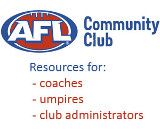Footy Fitness
|
|
The main topics that will be covered here are:
• Myths and Fallacies surrounding Strength and Conditioning
• Provide Strength training tips
• Provide Flexibility tips
• Provide Conditioning tips
• Provide Recovery and Injury Management tips
• Provide Performance Nutrition tips
• Much More…..
Before we look into to the future we must take a look into the past and see what was once footy in the USA. During the three years that I have my playing the sport of footy, I have seen marked development of the types of players that are participating. When I joined the Arizona Australian Football League three years ago there was a definite mix of players looking to have fun and socialize along with some serious athletes looking for a competitive atmosphere in which to participate. Since then, AZAFL has experienced a huge insurgence of youth (more specifically athletic youth) which has changed the landscape of the AZAFL, for the betterment of the sport in my opinion.
Not only are these players younger and more athletic, but they are also coming into the organization with levels of strength and condition that were not previously present. The reason for this is that most of these new players are coming in with a background in others sports and some experience in the realm of strength and conditioning. The end result being that they are making an immediate impact for their respective teams, in spite of their lack of footy skills.
On the other hand there are many players that got a late start and are starting to reach the twilights of their careers. Strength and conditioning training can be a virtual fountain of youth for these players, due to the fact that their skill levels are likely nearing a plateau based on a relative time line, and that strength and conditioning is a low cost: high benefit activity.
I am sure that there are many instances across the country involving the dilemma with having an experienced and more skilled player with poor strength and conditioning, competing with less skilled but more physically prepared player. The implementation of a team strength and conditioning program nullifies this dilemma.
The overall benefit being of team strength and conditioning program:
1. Having young players that can immediately compete, while continuing to work on their skills.
2. Allowing to the veteran i.e. more skilled players to continue be valuable both on the field of play and as skill facilitators for the younger players.
3. The final product being a team that can compete at a higher level of competition.
As the overall skill levels of the players’ progress, strength and conditioning is going to play and even larger role in delineating the winner and losers. The reason is if you match two players with equal skills, then next deciding factor will be physical preparedness, in which the more physically prepared athlete will dominate.
Although footy in this country is still very much and amateur sport and is being played solely for the love of the game. It is no longer a part-time affair, where you only “work” on footy for few weeks before the season and during the season. In most areas of the country there are usually several month’s of off-season, this a prime time to work on developing strength and conditioning that will pay-off during the season. This strength and conditioning program should not be completely abandoned when the season starts just tapered back to a lesser degree to allow for the adequate recovery from practice and competition.
Hopefully, you can now see the distinct value of participating in a strength and conditioning program not only as an individual, but also the overall benefit of having a team that is that is physically prepared to handles the demands of the sport and competition.
Troy M Anderson
US Revolution Strength and Conditioning Coach
Integrated Evolution, LLC
integratedevolution@cox.net
www.integratedevolution.org
|
|
|





